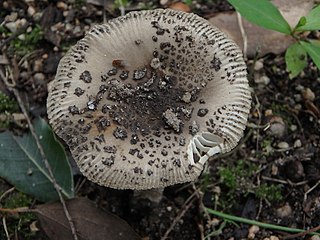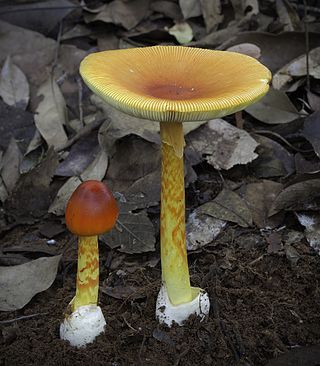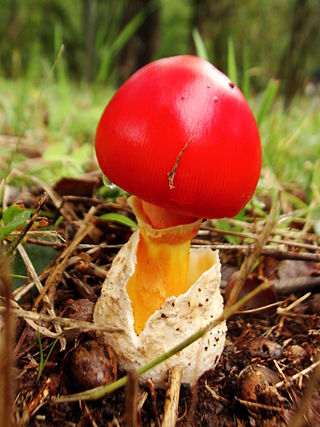Amanita altipes, also called the yellow long-stem amanita, is a species of agaric fungus found in coniferous woodlands in southwestern China.
Amanita parvipantherina, also known as the Asian small panther amanita, is a Chinese species of agaric which fruits in July and August. It has a brown cap up to 6 centimetres wide covered with whitish remnants of the universal veil. The stem is up to 9 cm tall. The similar A. pantherina is usually larger and less fragile, with fainter striations around the cap margin.

Amanita liquii, also known as the dark-faced ringless amanita, is a species of agaric that fruits from July to September.

Amanita subjunquillea, also known as the East Asian death cap is a mushroom of the large genus Amanita, which occurs in East and Southeast Asia. Potentially deadly if ingested, it is closely related to the death cap A. phalloides.

Amanita hemibapha, commonly known as the half-dyed slender Caesar, is a species of agaric found in southeast Asia and Oceania, although some distribution reports may refer to different taxa.

Amanita exitialis, also known as the Guangzhou destroying angel, is a mushroom of the large genus Amanita. It is distributed in eastern Asia, and probably also in India where it has been misidentified as A. verna. Deadly poisonous, it is a member of section Phalloideae and related to the death cap A. phalloides. The fruit bodies (mushrooms) are white, small to medium-sized with caps up to 7 cm (2.8 in) in diameter, a somewhat friable ring and a firm volva. Unlike most agaric mushrooms which typically have four-spored basidia, the basidia of A. exitialis are almost entirely two-spored. Eight people were fatally poisoned in China after consuming the mushroom in 2000, and another 20 have been fatally poisoned since that incident. Molecular analysis shows that the species has a close phylogenetic relationship with three other toxic white Amanitas: A. subjunquillea var. alba, A. virosa and A. bisporigera.

Amanita pseudoporphyria, also known as Hongo's false death cap, is a species of agaric fungus from the genus Amanita.

Amanita fuliginea, commonly known as the east Asian brown death cap, is a species of deadly poisonous mushroom in the family Amanitaceae. The fruit bodies have convex, dark gray to blackish caps measuring 3–6 cm (1.2–2.4 in) in diameter. The gills, largely free from attachment to the stipe, are white and have short gills (lamellulae) interspersed. The spores are roughly spherical, amyloid, and typically measure 8–11 by 7–9.5 µm. The species was described as new to science by Japanese mycologist Tsuguo Hongo in 1953. A. fuliginea is classified in Amanita section Phalloideae, which contains the infamous destroying angel.

Amanita manginiana, also known as Mangin's false death cap, Chiu's false death cap, is a species of the genus Amanita.

Amanita caesareoides is a species of Amanita from China, Korea, and Japan.
Amanita pallidorosea is a mushroom of the large genus Amanita, which occurs under beech and pine in China and Japan. It is closely related to the destroying angel A. bisporiga.
Amanita subpallidorosea is a mushroom of the large genus Amanita, which occurs under oaks in southern China and Taiwan.
Amanita subfuliginea is a mushroom of the large genus Amanita, which occurs central and southern China. It is closely related to the east Asian death cap A. fuliginea.
Amanita griseorosea is a mushroom of the large genus Amanita, which occurs under beech in southern China. It is closely related to A. molliuscula.
Amanita molliuscula is a mushroom of the large genus Amanita, which occurs under beech in Shaanxi Province in China. It is closely related to A. griseorosea.
Amanita parviexitialis is a mushroom of the large genus Amanita, which occurs under beech in southern China.

Amanita flavipes is a species of Amanita found in oak and conifer forest of China, India, Japan, Pakistan, and South Korea.

Amanita sculpta is a species of Amanita. It is distinctive because of its large size, with caps 10 to 27 centimetres in diameter. The cap's appearance, beige and dark brown with pileal warts, has been compared to that of a chocolate chip cookie.

Amanita neoovoidea is a species of Amanita found in China and Japan












